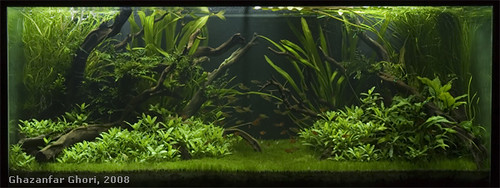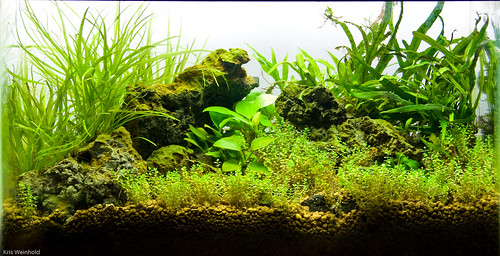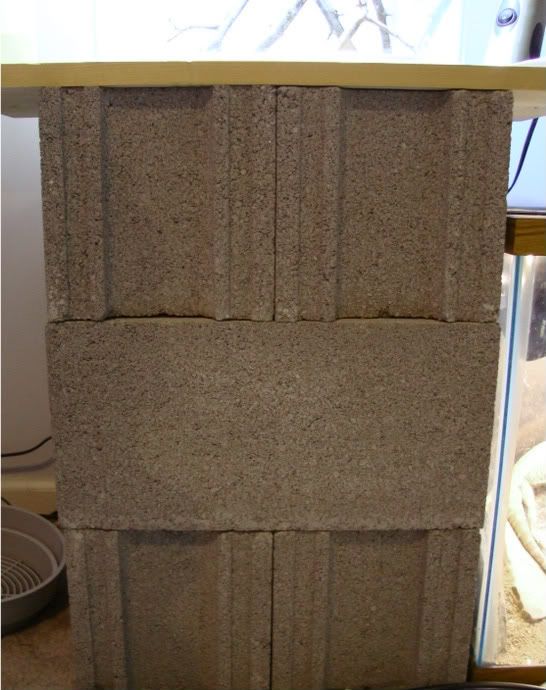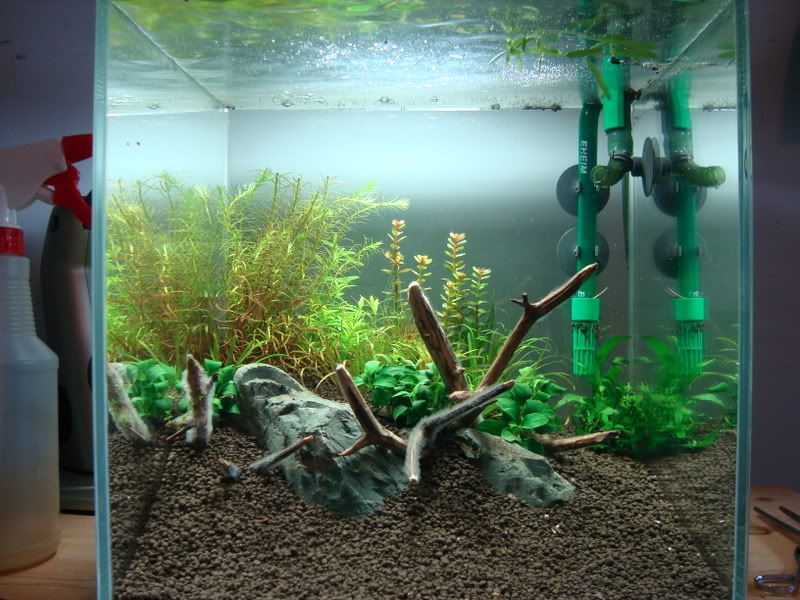Choosing the Right Aquarium
January 23rd, 2009Starting a planted aquarium can seem like a daunting task. Most hobbyists start out small, gradually learning by trial and error what works and what doesn’t, and piece together information from books and websites until they finally either succeed or get frustrated and leave the hobby forever. In this series of posts, I’m going to attempt to outline the most important aspects of setting up a planted aquarium. Hopefully this will become a valuable resource to anyone new to the hobby, or experienced fish-keepers who are looking to setup a planted aquarium.
Perhaps an understatement, the actual physical aquarium is very important to a planted aquarium. The dimensions will impact the type of aquascape that you can implement, the design can influence its integration into your room, and the features can determine how equipment will function within the aquarium.
Dimensions
In general, larger aquariums (40+ gallons) are easier to upkeep than smaller aquariums. In addition to having the space to fit all sizes of plants, larger aquariums are not as prone to wild swings in water chemistry. Of course, larger aquariums have higher costs/space requirements than smaller setups, so if these things are issues, try not to start with anything smaller than 10-20 gallons. Nano aquariums are very much in style right now, but they’re more difficult to maintain, so I would recommend that beginners save those for another time.
Once you have selected the general volume of your aquarium, it is important to consider the actual dimensions. While any aquarium can be aquascaped, there are certain dimensions that are especially easy to work with. In general, aquariums with near equal ratios of depth and height are considered great aquascaping tanks. Some excellent aquarium sizes are 20L (30 x 12 x 12), 50G (36 x 18 x 18), and 75G (48 x 18 x 20). There are good reasons for this. For example, a popularly sold aquarium size is the 55G (48 x 13 x 20) tank. While the width and height are nice, the tank is only 13″ deep, making it extremely difficult to fit a complete foreground, midground, and background that transition smoothly between one another. In this case, I’d recommend getting a 75G because the extra 5″ of depth you gain are invaluable when aquascaping. Try to avoid extremely tall tanks, as you may need to purchase more intense (and expensive) lighting to adequately light from top to bottom. That said, I prefer an aquarium at least 16″ tall so that the stem plants have room to grow and branch toward the surface. I consider the perfect planted aquarium, the 50G aquarium, as it is not so wide that it is difficult to provide a coherent aquascape from left to right, and has sufficient depth and height to design a nicely proportioned aquascape.
Design & Stand
 A very important thing to establish up front is whether or not you want your planted aquarium to be a centerpiece that is integrated into the design elements of the rest of the room. Planted aquariums have a potential to really light up a room, and provide that wow factor when people enter. If this is your intention, you may wish to consider a rimless aquarium, which is a tank without the plastic trim along the top and bottom, and without the visible silicon lines along every seam. In addition, the stand that you place your tank on can impact the impression that your planted aquarium conveys. The cheapest possible stand is probably cinder blocks with plywood, which can have a fairly modern look to it. There are a number of nicely finished wood stands available, and I’ve seen some very well done DIY stands using cabinet doors and hardware over-top of a 2×4 support structure. All-in-all, make sure not to look past the design aesthetic of the tank and stand when planning your planted aquarium.
A very important thing to establish up front is whether or not you want your planted aquarium to be a centerpiece that is integrated into the design elements of the rest of the room. Planted aquariums have a potential to really light up a room, and provide that wow factor when people enter. If this is your intention, you may wish to consider a rimless aquarium, which is a tank without the plastic trim along the top and bottom, and without the visible silicon lines along every seam. In addition, the stand that you place your tank on can impact the impression that your planted aquarium conveys. The cheapest possible stand is probably cinder blocks with plywood, which can have a fairly modern look to it. There are a number of nicely finished wood stands available, and I’ve seen some very well done DIY stands using cabinet doors and hardware over-top of a 2×4 support structure. All-in-all, make sure not to look past the design aesthetic of the tank and stand when planning your planted aquarium.
Aquarium Features
There are many different types of aquariums, and while all can be used for planted aquariums, some are more suitable than others. When choosing between an acrylic or glass aquarium, I prefer glass. The reason is that your planted aquarium will inevitably get algae on the glass that will need to be removed. While it’s possible to scratch a glass tank, it’s much easier to do so with acrylic. In addition, the clarity of many of the glass tanks are unsurpassed by acrylic, especially in the corners where distortion is often present. That said, acrylic does have advantages in weight and strength for large aquariums, but if given the choice, I choose glass.

Ghazanfar Ghori’s 215G with Hidden Overflows
Additionally, some aquariums come outfitted with overflows, standpipes, bulkheads, etc… These items are often required if you plumb your aquarium into your house’s drain or water supply, or if you intend to place the tank in the center of your room, and do not want visible hoses or cords on one side of the tank. However, if you do not intend to do any of these things, and you do not plan to use this same aquarium for a reef-tank later in its life, I would recommend avoiding them. These features take up space within the aquarium itself, and are usually not that attractive. This means that when aquascaping you will want to try and cover them up as best you can with tall plants, which could limit your options.
Summary
While it’s possible to simply run out to your local aquarium store and buy whatever aquarium they have in stock, some forethought about the matter is definitely required to ensure a successfully designed planted aquarium. Of course, there are an infinite number of possibilities that could work, but the most common principles have been outlined in this article. Good luck shopping!

January 23rd, 2009 at 11:45 am
I am always annoyed at how _ugly_ the vast majority of commercially produced stands are (IMO, obviously), especially for large aquariums. More often than not all I can find are those pine panel things in either black or orange “oak finish”. The one commercial line I liked got discontinued before I could afford to buy it new. My 125 is up on 2x4s until I can find some cabinet doors I like. I have also used other furniture in place of commercial stands. For example, the 55 and 5 in our dining room are on top of a cherry sideboard and an endtable/wine rack, respectively.
January 23rd, 2009 at 1:56 pm
I agree OG. I do like some of the dark maple/cherry finished stands+canopies that are available commercially though. Furniture is often the most unique/integrated solution, but you really have to be sure that it’s sturdy enough to support the weight, and durable enough to deal with the inevitable water spills.
January 23rd, 2009 at 2:14 pm
Oh definitely. The sideboard we use unfortunatly has a finish that water stains really easily. We compensate by covering the top with acrylic to ward off splashes, fill with water cooler bottle instead of a bucket to control the incoming flow better, and I’m sort of “oh well” about the rest because it’s not in the best shape anyway and needed to be refinished before we started using it.
It’s almost too bad that tvs have gotten so much lighter because the tv stands of old would probably work very well for aquariums, if they’re not made out of pressboard. When I consider furniture as stands, I make sure that I’m using solid wood. No IKEA furniture! Although, I’m pretty sure one stand we have from Petsmart is actually made out of pressboard. Makes me glad we’re tearing it down once the basement is finished.
I’m not crazy about the cherry finishes you find because they’re just too purple for me. But if you couldn’t tell, I am very, very picky. 😀
January 24th, 2009 at 12:03 am
I set up a one foot cube and used cinder blocks to make it, and I’m actually quite impressed with the look (note, it’s not that purple)

The tank is still in progress, and has ug planted in the foreground now.
I was so impressed by the stand that I made a matching one for a mini m. The only downside with my design is that there is no storage 🙁 Oh well, not bad for $9
January 25th, 2009 at 4:47 pm
With tornado season approaching, I’m once again wondering about air during a power outage. Do you use any kind of UPS or battery powered air device if the power goes out? My shrimp tanks all use a power filter and a sponge filter, so if the power goes out I’d like to power the sponge filters. I’ve seen several battery powered air pumps you can use daily and kick in when the power goes out. I was wondering if you use one or what you’d recommend that can power 5 sponge filters. And is there a quiet one? Maybe UPS would be better?
January 25th, 2009 at 4:49 pm
And also what is that white fuzz on the picture above on the driftwood? I think a few yellow shrimp in that tank would look beautiful!
January 25th, 2009 at 6:29 pm
That is some nasty driftwood fungus 😉 The snails have almost eaten it all already
January 25th, 2009 at 6:49 pm
Nice fungus! Looks like stuff I find under my kids beds sometimes:)
I’m on the hunt for “Phyllanthus fluitans” Red Root Floater, if anyone happens to have some:)
January 25th, 2009 at 7:57 pm
Fungus is pretty coming on new driftwood. Plecos/Otos love the stuff!
Kim, I’m pretty lucky not to have many power outages each year, so I don’t worry about backup power systems. I imagine a UPS would be the easiest thing to add. Just make sure it doesn’t get wet!
May 27th, 2013 at 7:38 pm
Hi Kris
You asked me to let you know the article I’ll be using next in case it needed updating “Choosing the Right Aquarium”
I’ll be doing the newsletter next week